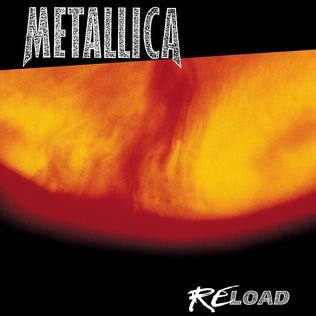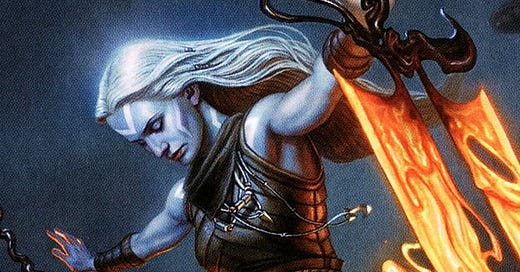Stoneforge Mystic, Metallica's Load/Reload and Changing Contexts over Time
In our pilot episode of The Third Power, I had some hesitation about including Stoneforge Mystic in my cube. When we started our podcast in 2011, the newly shown Sword of Body and Mind looked to supplement the package of heavy hitters like Skullclamp, Loxodon Warhammer, Basilisk Collar, Umezawa’s Jitte and friends; I decided to take the plunge on Stoneforge Mystic and was happy that I did.
With Sword of Feast and Famine, Batterskull and Sword of War and Peace coming soon after, eventually it became a stock inclusion in cubes, even if it took years later than it arguably should have. Over the years, the sword cycle fell out of a lot of cubes where Stoneforge Mystic would play (aka cubes with rares in them.) It made me think of the role of Stoneforge Mystic these days.
I’ve often talked a lot over the years about context in cube and outsourcing evaluation of cards from other formats to cube. I’ve even talked about how evaluation can change from cube to cube. But, there hasn’t been a lot of talk about how card itself can change in a cube over time.
Over time, even in cubes that curtail their power levels, generally cubes are looking to include more powerful cards over time to make it so that the average card power level increases over time. You’ll often hear, when talking about maintaining a cube - particular in the context of making cuts - that cards can reach the point where they’re no longer good enough. “Cut card X because it’s not good enough, add card Y because it’s good.” Pretty basic stuff. But sometimes, it isn’t so much that the card gets powercrept in or out over time, but that its function can change in a cube over time.


On my first appearance on the Uber Cube podcast, I talked about Metallica’s Load and Reload albums. To provide some context, Metallica’s Load was released 5 years after their monumental self-titled album (generally referred to as “The Black Album”) which put them front-and-center in the mainstream as metal’s torchbearers, when the genre found itself dying in the early 1990s.
When Load came out in 1996, initial reception to it was… not what people expected. The band members cut their long hair and the Load album was much more hard rock than metal. I didn’t get into Metallica until a few years later, via the eponymous self-titled album, because of course - the hits from that album were still played all the time on rock stations. I ended up getting Load as my initial foray into getting into heavy music and thought it was fine, but generally enjoyed the Black album more. A year later, Metallica released Reload, which was mostly more of the same of Load. The Black album was one of the more influential albums I purchased, as it portended my foray into the many subgenres of metal years later.
One of those things I’d regularly hear about in metal circles and discourse about Metallica’s Load and Reload albums - were they underrated because they weren’t the metal Metallica we knew? Are the songs themselves just not as good? (I always personally thought it was the latter - the songs weren’t as good, and some songs were just filler-tier.) I’d see similar things with bands who had changes with a primary band member change: Van Halen with David Lee Roth vs Sam Hagar, Sepultura with Max Cavalera vs Derrick Green, Black Sabbath with Ozzy Osbourne vs Ronnie James Dio vs Tony Martin, Dream Theater with Mike Portnoy vs Mike Mangini - the question would remain the same.
“Is it the same band?” “Is it still worth caring about the band?” Usually, the correct answer was yes, but I’d too often find people dismissing the bands because things weren’t the same as before.
These kinds of things came to mind with Stoneforge Mystic and, despite the Sword cycle falling out of cubes and losing the potential critical mass of targets to make it consistently work - maybe I had a way to make it work in a different context.
Enter: Cranial Plating and Nettlecyst.
In a smaller cube that would have Stoneforge Mystic, it’s pretty easy to have critical mass for targets: Skullclamp, Kaldra Compleat, Umezawa’s Jitte, etc - but once a cube gets bigger, it’s harder for it to get that A+B synergy of Stoneforge + Kaldra, and as a designer with a larger cube, it can come to a point where a card that works incredibly well in a smaller iteration wouldn’t work as well.
But again, that’s easy. Its best targets get diluted with a larger cube. Duh.
When I did my CubeCon 2024 panel, when talking about the different types of synergy in cube, I included this slide to illustrate about how Stoneforge Mystic’s role may change over time.
If a cube were to include the artifact-heavy players like Nettlecyst and Cranial Plating, suddenly the card isn’t just a standalone A+B piece for a busted equipment: it then becomes, at least in part, a card that gets its artifact-heavy payoffs.
Sets like Aetherdrift haven’t quite made it so that the usual white deck has enough incidental artifact cardboard to work, but cards like Thraben Inspector and friends have been helping drive that train for years. Eventually, it’ll get to the station but in the meantime, cards like Nettlecyst and Cranial Plating aren’t for every white deck, and that’s ok. Stoneforge Mystic may have changed singers, but she still makes absolutely great music.
Some cards, like Flash, weren’t played much in the early days of cube - partially out of just being unaware of how good the card was, and partially from the cheat targets being not that great with Flash. With cards like Vaultborn Tyrant and Atraxa, Grand Unifier still having good value if “evoked” for 1U, eventually Flash became much easier to support.
It’s why I’ve been a fan of using a cube sideboard, because sometimes a card can come back to a cube because the environment may not have been right for it before, but now is because of how things change - whether it’s cards like Galvanic Blast incidentally having an easier time hitting metalcraft and with more small creatures, cards like Gingerbrute getting better in the context of being to grab monarch/initiative back, Primeval Titan taking on more of a role of utility land finder ala Talon Gates of Madara, Horizon of Progress and Lazotep Quarry or the usual inclusion of more answers to card types because the format’s seeing more of them (creatures, artifacts, planeswalkers, etc.) Cube’s a wonderful malleable world and cards themselves can be too in their roles over time.
Thanks for reading.




